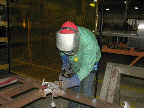Industrial Hygiene Blogs So Far
This is the fifth in a series of blogs on industrial hygiene (IH). The first one explained that industrial hygiene was the recognition, evaluation, and control of hazards in the workplace. The second blog defined a hazard as a source of danger or an agent which has the potential to cause harm to a vulnerable target. Sources of hazards were identified in manufacturing, construction, maritime, office, and other workplaces. Different types of resources were identified such as guidelines provided by the U.S. Occupational Safety & Health Administration (OSHA, www.osha.gov) and the National Institute of Occupational Safety & Health (NIOSH, www.cdc.gov/niosh). The third blog focused on the recognition or identification of hazards. The fourth one walked you through an example of hazard recognition for a specific operation. And this blog will provide an overview of the evaluation of industrial hygiene hazards.
Types of Evaluation
So you have identified the potential hazards through the recognition process and now you are ready to evaluate the hazards. There are a few ways that this can be done.
One is to estimate what the air concentrations of the chemical or dust of concern are from analyzing the operation or manufacturing method. For example, certain assumptions are made as to how much of a paint or substance ends up on the part and then estimate how much ends up in the air. You would have to use the Safety Data Sheet and Technical Data Sheet to determine the concentration of the hazardous chemical in the product being used or applied. You have to determine how much goes off as a vapor for things like paint to estimate volatile organic compounds (VOCs, such as solvents) and how much overspray there is to account for particulates.
 Another option for an operation that is established and being used is to monitor the complaints or adverse health conditions. Then those are compared to potential health impairments identified on the Safety Data Sheet. This may actually tell you what the constituent of most concern is. Take note that we are not recommending this approach since it can put workers at unacceptable risk. However, we have had enough years in the field that tell us processes are often established and used regularly without the proper evaluation.
Another option for an operation that is established and being used is to monitor the complaints or adverse health conditions. Then those are compared to potential health impairments identified on the Safety Data Sheet. This may actually tell you what the constituent of most concern is. Take note that we are not recommending this approach since it can put workers at unacceptable risk. However, we have had enough years in the field that tell us processes are often established and used regularly without the proper evaluation.
Another approach is control banding. This groups chemicals according to similar characteristics, which may be physical or chemical. Then, based on these characteristics, you decide how the chemical will be used and what the anticipated exposure hazards will be. Appropriate work methods and controls are selected to eliminate or at least minimize the workers’ exposures.
Finally, there is industrial hygiene testing. When properly completed, this is the best method to conclusively decide if there is truly a potential exposure to the workers.
So that concludes our overview of hazard evaluation in industrial hygiene. In our next blog in this series, we will discuss specific evaluation of potential industrial hygiene hazards. That process often includes industrial hygiene testing.
 In the meantime, if you need any help, Environmental Safety Consultants (www.escflorida.com) is here. We are a Florida licensed environmental engineering company with a CIH on staff. We have the credentials and experience to help you complete your industrial hygiene project. We have a proven track record with a Florida licensed environmental engineer and mold assessors, plus degreed environmental scientists on staff. We specialize in industrial hygiene, indoor air quality, asbestos, lead paint, silica, noise, and more.
In the meantime, if you need any help, Environmental Safety Consultants (www.escflorida.com) is here. We are a Florida licensed environmental engineering company with a CIH on staff. We have the credentials and experience to help you complete your industrial hygiene project. We have a proven track record with a Florida licensed environmental engineer and mold assessors, plus degreed environmental scientists on staff. We specialize in industrial hygiene, indoor air quality, asbestos, lead paint, silica, noise, and more.
We are just a telephone call (800-226-1735) or an e-mail away (escinc@verizon.net). Contact us today!
